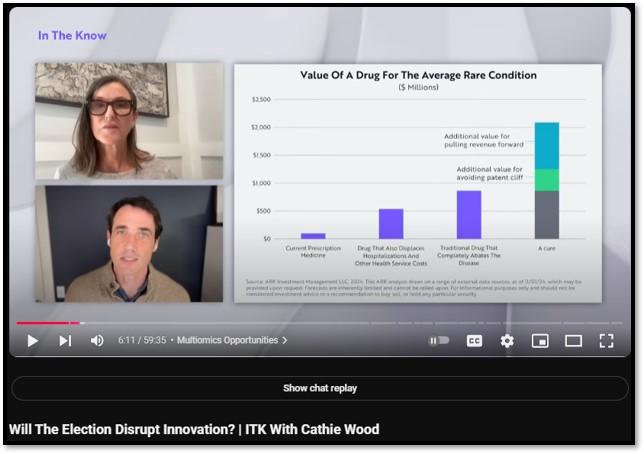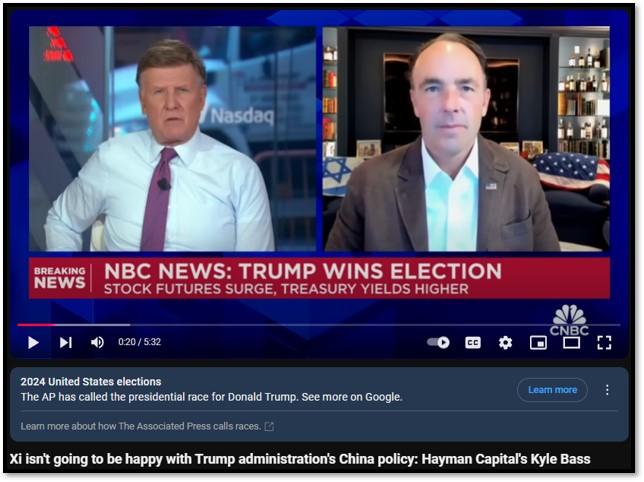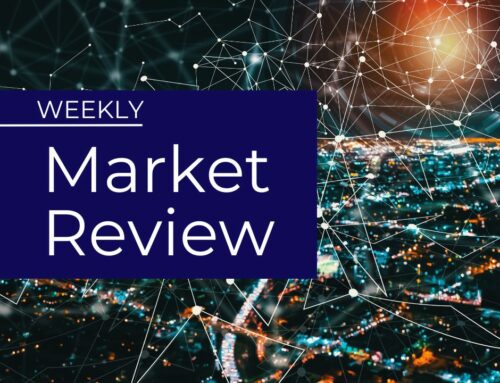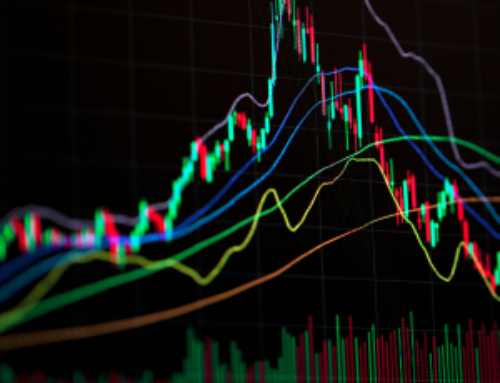

- 1. The U.S. stock market rally can be attributed to a combination of factors, including optimism about a possible rate cut at the upcoming Federal Reserve meeting, where investors expect a 25 basis-point reduction.
- 2. Municipal bonds have experienced significant fluctuations, particularly during the recent cycle of interest rate hikes.
- With the current macro-economic backdrop, below are areas we currently favor:
- 3. This week, I am sharing this “Power Episode” featuring Cathie Wood and Brett Winton with you.
- 4. World Watch
- 5. Quant & Technical Corner
1. The U.S. stock market rally can be attributed to a combination of factors, including optimism about a possible rate cut at the upcoming Federal Reserve meeting, where investors expect a 25 basis-point reduction.
This anticipated cut has fueled positive sentiment, as lower borrowing costs could support both economic growth and corporate earnings. Additionally, anticipation of favorable economic policies under a new administration has bolstered investor confidence, while easing inflation data has alleviated concerns about further aggressive rate hikes. Expectations of a combination of lower interest rate environment, reduced corporate tax rates, and some degree of deregulation have all contributed to the rally. Together, these elements have created a risk-on environment, encouraging investors to buy equities across various sectors, pushing major indices higher and reflecting broader optimism in the market. The question remains: was this rally premature? Only time will tell…
Tesla (ticker: TSLA) remains a favorite in our investment strategies. Below please find Deepwater Asset Management’s Gene Munster’s take on what Trump’s win means for Elon Musk and Tesla. Click onto picture below to access video. I personally own Tesla, and many of our investment strategies have Tesla. REF: CNBC
2. Municipal bonds have experienced significant fluctuations, particularly during the recent cycle of interest rate hikes.
Rising rates generally decrease the appeal of fixed-income investments like muni bonds, leading to price declines as investors seek higher yields elsewhere. However, as the rate hike cycle nears its peak, muni bonds appear to be entering a “sweet spot” for a potential recovery. With rates stabilizing, muni bonds are now more attractive, offering relatively high yields and tax advantages for income-focused investors. Additionally, municipal governments often maintain strong credit ratings and financial stability, which can appeal to investors seeking a balance of income and security. This environment creates an opportunity for a “recovery bounce,” as investors anticipate both income potential and possible price appreciation in the coming months. Below are a few examples of Muni-bond related exchange-traded funds / closed-end funds we use for this strategy. (Not investment advice – speak to your financial advisor to understand if muni-bond funds are suitable for you)
- iShares National Muni Bond ETF (MUB) – SEC Yield: 3.35%
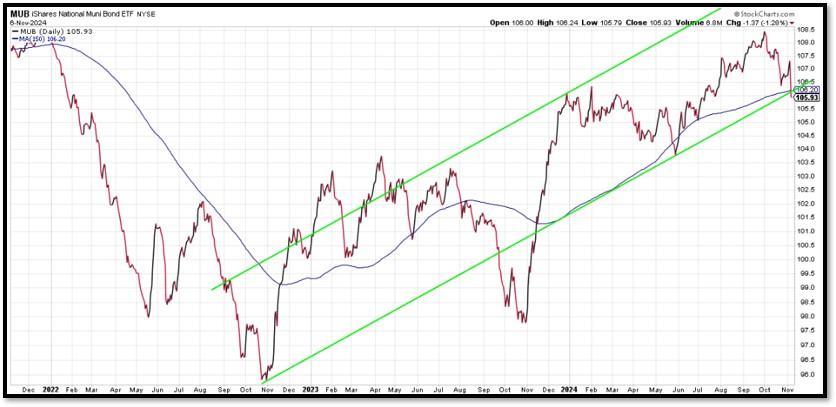
- abrdn National Municipal Income Fund (VFL) – Total Distribution Rate: 5.73%. This is a leveraged closed-end fund, currently in a technical bearish to bullish technical formation.
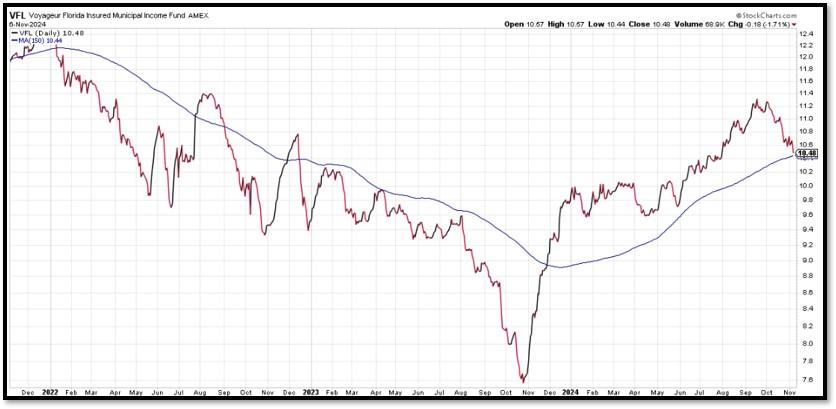
- BlackRock MuniYield Quality II (MQT) – Total Distribution Rate: 5.90%. This is a leverage closed-end fund, currently also in a bearish to bullish technical formation.
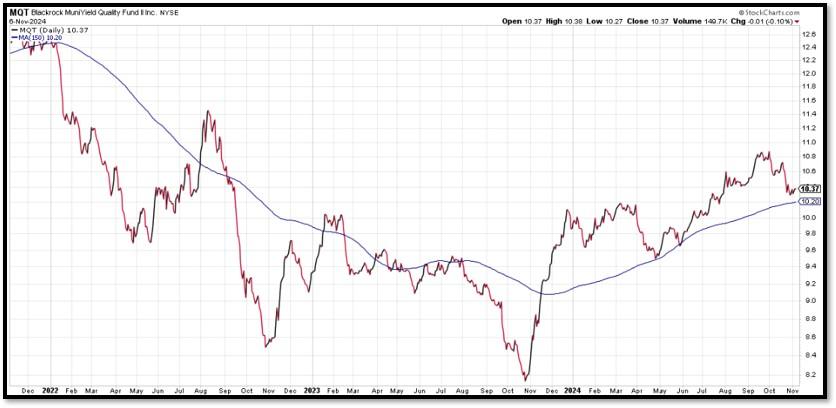
With the current macro-economic backdrop, below are areas we currently favor:
- Fixed Income – Short-term Corporates (Low-Beta)
- Fixed Income – Corporates High Yield as Opportunistic Allocation, Non-US (Low-Beta)
- Businesses that contribute to and benefit from AI & Automation (Market-Risk)
- Small Cap & Mid Cap Stocks (Market-Risk)
- Utilities (Market-Risk)
- Healthcare & Biotechnology (Market-Risk)
- Gold (Market-Risk)
- Industrials (Market-Risk)
3. This week, I am sharing this “Power Episode” featuring Cathie Wood and Brett Winton with you.
ARK CEO/CIO, Cathie Wood is joined by ARK’s Chief Futurist Brett Winton to discuss the market implications of the US presidential election as well as exciting opportunities in the genomics space. What stands out to me is Brett’s explanation that curing diseases can actually be good business. Cathie also breaks down the jobs report, among other economic data. We use (ARKK) in many of our investment strategies. I believe the premise is set for ARKK “2.0” to outshine its peers in the publicly traded innovation space. REF: ARK-Invest
4. World Watch
4A. Trump’s US Presidential win signals more confrontation with China according to The Wall Street Journal. Trump has historically pursued a confrontational stance towards China, viewing its economic practices, trade policies, and regional ambitions as major threats to U.S. interests. Under a second Trump administration, the U.S. could see intensified trade restrictions, increased tariffs, and further decoupling in critical technology sectors. Additionally, Trump may adopt a more assertive stance on geopolitical flashpoints such as Taiwan, which would strain diplomatic ties and raise regional tensions. The overarching theme of this approach is likely to be an “America First” posture that emphasizes economic sovereignty and diminished reliance on China. This policy aims to reinforce U.S. competitiveness and counter China’s rising influence globally. Click onto picture below to access video. REF: WSJ, CNBC
4B. China’s October exports data jumped by 12.7% year-on-year to USD 309.06 billion, surprisingly reaching a 25-month high and far surpassing the expected 5% growth. This sharp increase followed a modest 2.4% rise in September, marking the sixth straight month of export expansion and the fastest growth rate since July 2022. The surge reflects manufacturers accelerating orders ahead of potential new tariffs from the U.S. and the EU. Bloomberg reports that China’s recent stimulus measures have contributed to a significant surge in exports, bolstering the country’s economic performance amid broader global economic challenges. These measures, aimed at enhancing domestic economic stability, include targeted fiscal support, incentives for key industries, and actions to strengthen manufacturing and exports. This stimulus not only supports short-term export growth but also improves China’s competitive positioning globally. Despite ongoing uncertainties, these policies underscore China’s reliance on exports to drive economic growth, providing a temporary lift to its economy. Click onto picture below to access video with Bredan Ahern of KraneShares dated back in October. It’s important to understand what’s to expect when China continues its stimulus programs. REF: Bloomberg, CNBC, TradingEconomics
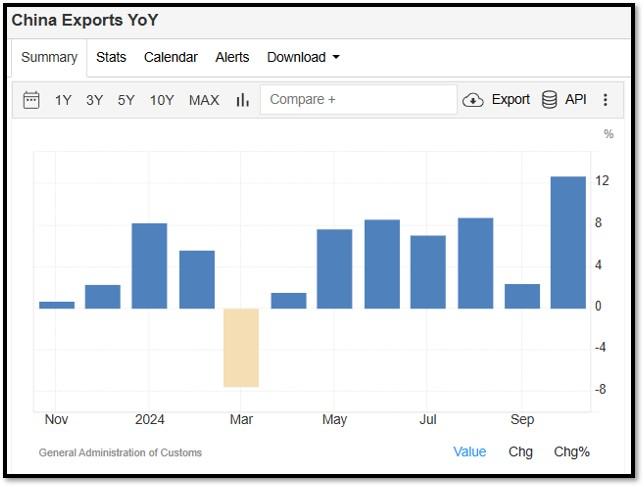
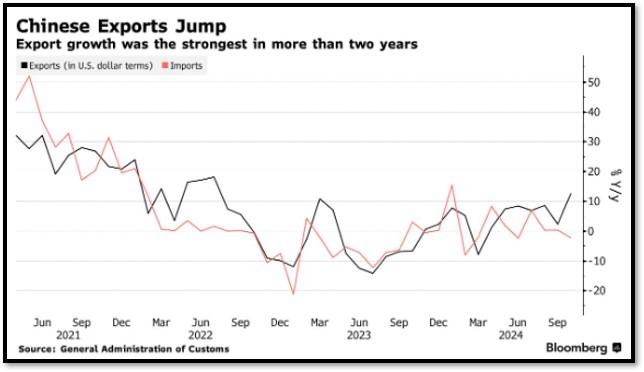
4C. Below is an updated snapshot of the current global state of economy according to TradingEconomics as of 11/4/2024. REF: TradingEconomics
- The US economy expanded an annualized 2.8% in Q3 2024, below 3% in Q2 and forecasts of 3%, the advance estimate from the BEA showed.
- The German economy expanded 0.2% qoq in Q3 2024, rebounding from a 0.3% fall in Q2, and beating forecasts of a 0.1% contraction, preliminary estimates showed. Government and household final consumption in particular, were up.
- Annual inflation rate in Germany accelerated to 2% in October 2024, the highest in three months, compared to 3-1/2 year low of 1.6% in September and above forecasts of 1.8%, preliminary estimates showed.
- The seasonally-adjusted unemployment rate in Germany increased to 6.1% in October 2024, the highest since February 2021, compared to 6% in the previous four months, and in line with expectations.
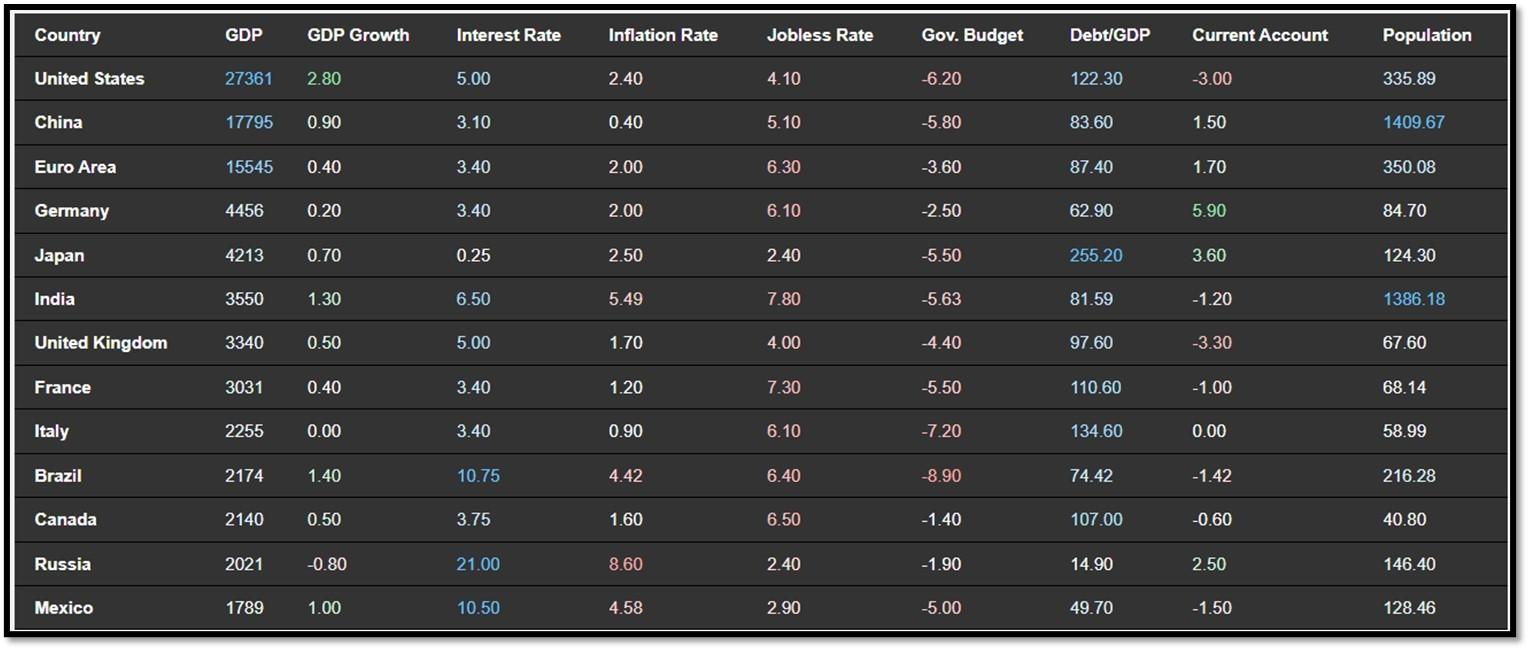
5. Quant & Technical Corner
Below is a selection of quantitative & technical data we monitor on a regular basis to help gauge the overall financial market conditions and the investment environment.
5A. Most recent read on the Fear & Greed Index with data as of 11/6/2024 – 8:00PM-ET is 58 (Greed). Last week’s data was 46 (Neutral) (1-100). CNNMoney’s Fear & Greed index looks at 7 indicators (Stock Price Momentum, Stock Price Strength, Stock Price Breadth, Put and Call Options, Junk Bond Demand, Market Volatility, and Safe Haven Demand). Keep in mind this is a contrarian indicator! REF: Fear&Greed via CNNMoney
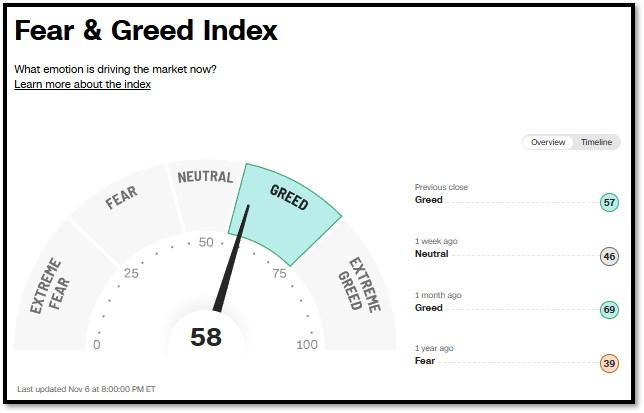
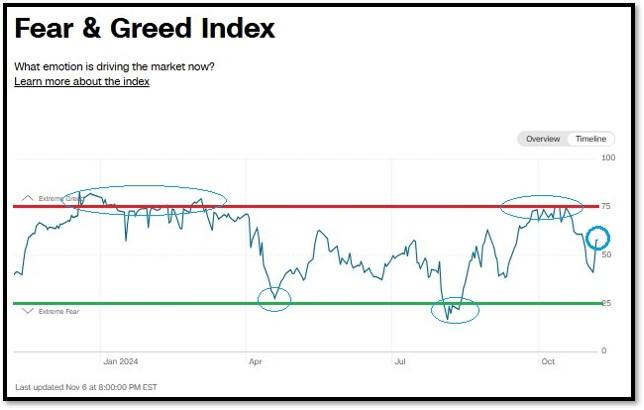
5B. St. Louis Fed Financial Stress Index’s (STLFSI4) most recent read is at –0.4004 as of October 31, 2024. A big spike up from previous readings reflecting the recent turmoil in the banking sector. Previous week’s data was -0.5358. This weekly index is not seasonally adjusted. The STLFSI4 measures the degree of financial stress in the markets and is constructed from 18 weekly data series: seven interest rate series, six yield spreads and five other indicators. Each of these variables captures some aspect of financial stress. Accordingly, as the level of financial stress in the economy changes, the data series are likely to move together. REF: St. Louis Fed
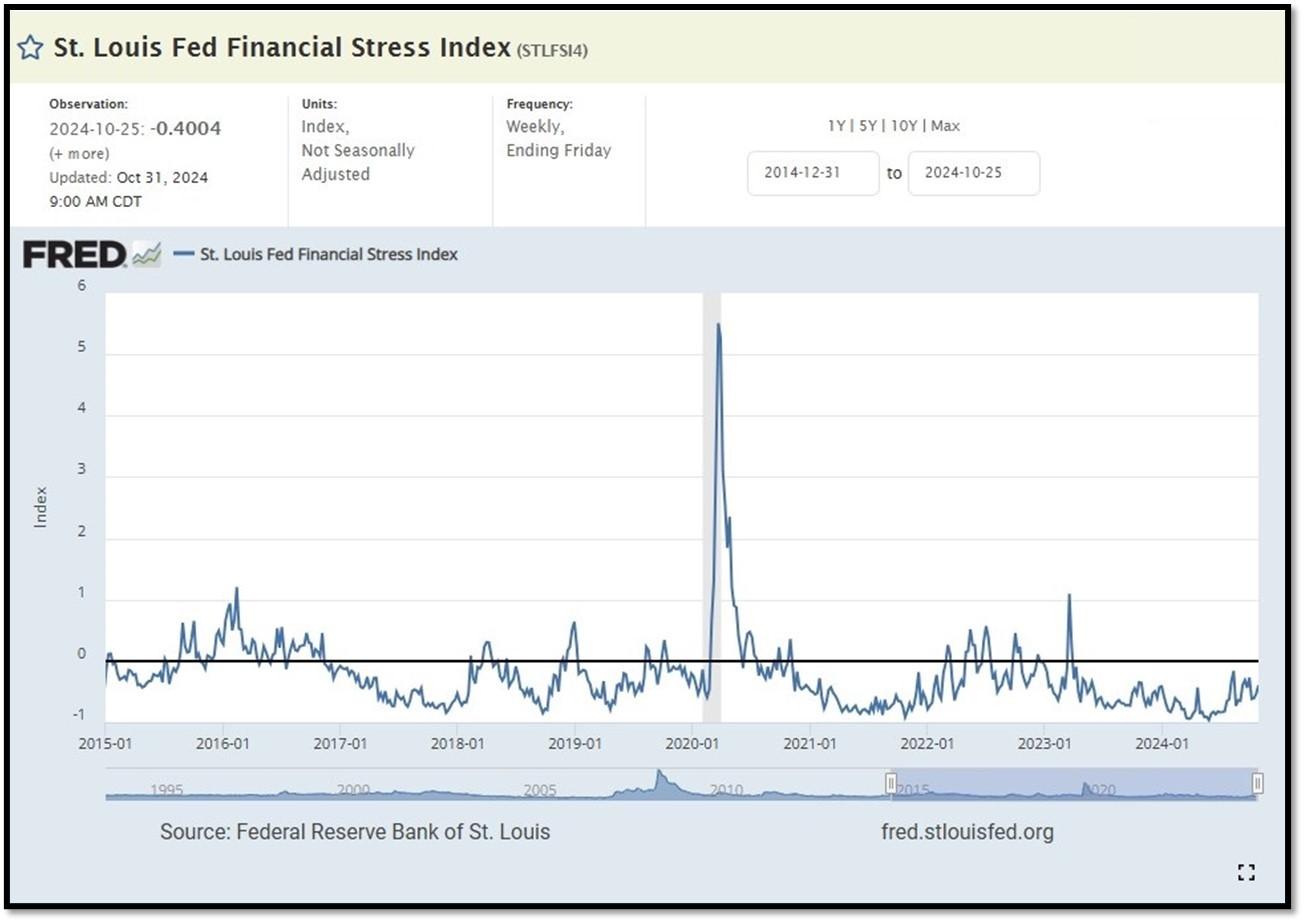
5C. University of Michigan, University of Michigan: Consumer Sentiment for September [UMCSENT] at 70.1, retrieved from FRED, Federal Reserve Bank of St. Louis, October 25, 2024. Back in June 2022, Consumer Sentiment hit a low point going back to April 1980. REF: UofM

5D. The Chicago Fed National Activity Index (CFNAI) decreased to –0.28 in September from –0.01 in August. Two of the four broad categories of indicators used to construct the index decreased from August, and all four categories made negative contributions in September. The index’s three-month moving average, CFNAI-MA3, decreased to –0.19 in September from –0.14 in August. REF: ChicagoFed, September’s Report
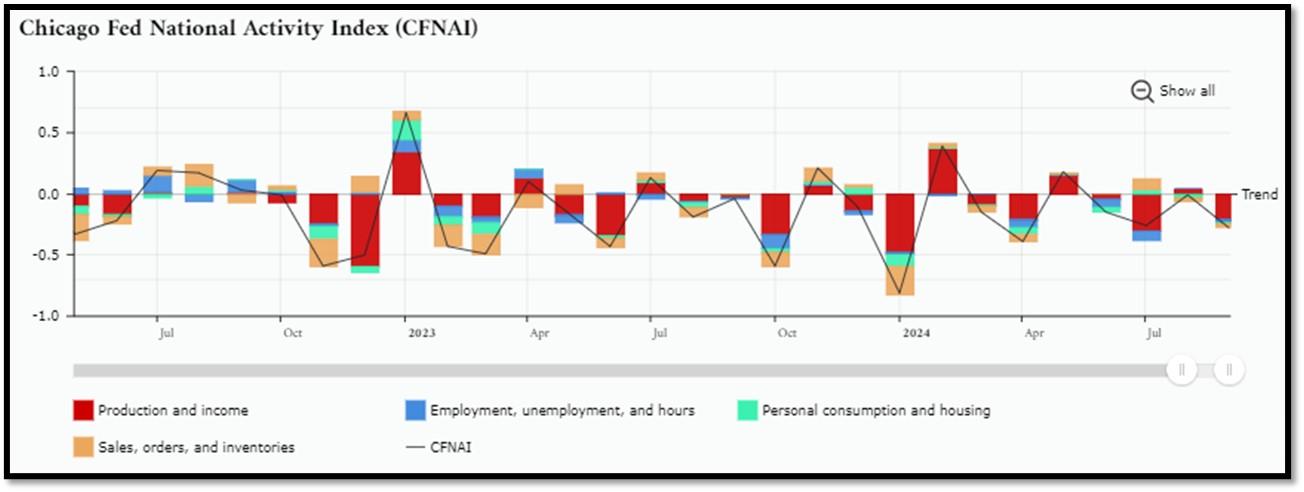
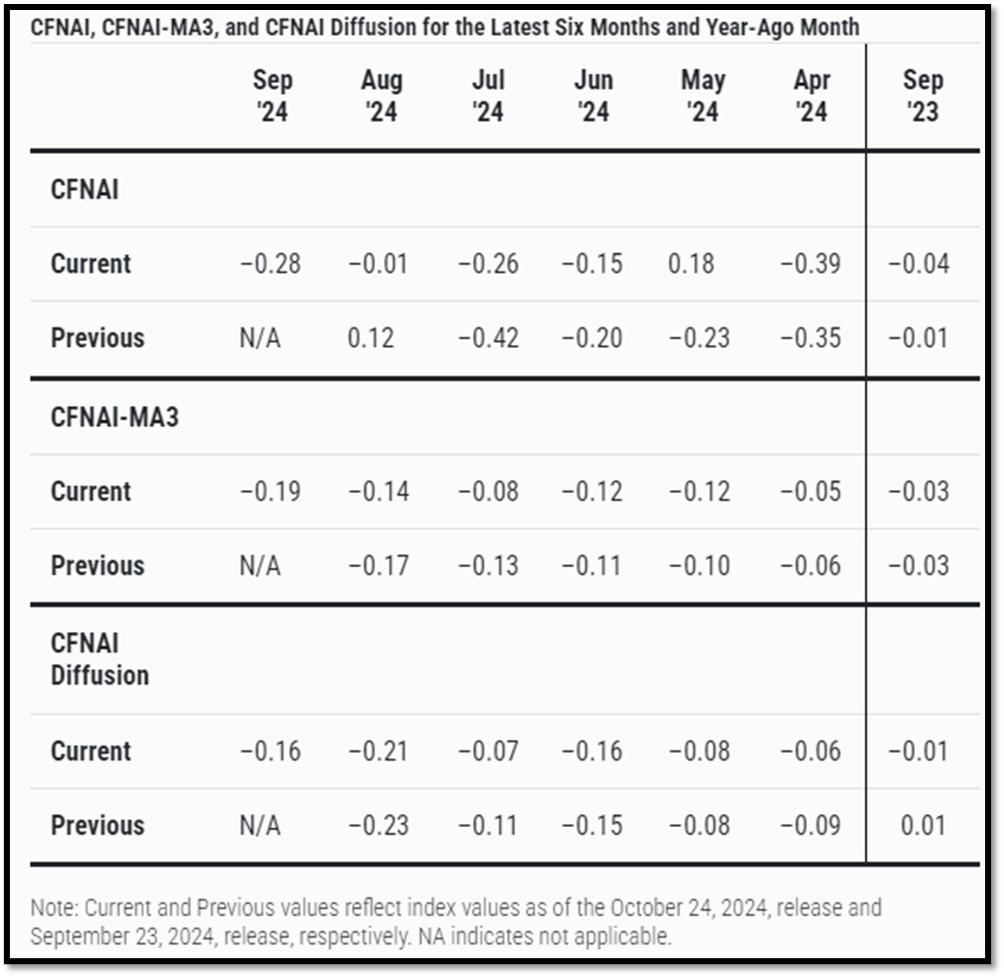
5E. (10/21/2024) The Conference Board Leading Economic Index (LEI) for the US declined by 0.5% in September 2024 to 99.7 (2016=100), following a 0.3% decline in August. Over the six-month period between March and September 2024, the LEI fell by 2.6%, more than its 2.2% decline over the previous six-month period (September 2023 to March 2024). The composite economic indexes are the key elements in an analytic system designed to signal peaks and troughs in the business cycle. The indexes are constructed to summarize and reveal common turning points in the economy in a clearer and more convincing manner than any individual component. The CEI is highly correlated with real GDP. The LEI is a predictive variable that anticipates (or “leads”) turning points in the business cycle by around 7 months. Shaded areas denote recession periods or economic contractions. The dates above the shaded areas show the chronology of peaks and troughs in the business cycle. The ten components of The Conference Board Leading Economic Index® for the U.S. include: Average weekly hours in manufacturing; Average weekly initial claims for unemployment insurance; Manufacturers’ new orders for consumer goods and materials; ISM® Index of New Orders; Manufacturers’ new orders for nondefense capital goods excluding aircraft orders; Building permits for new private housing units; S&P 500® Index of Stock Prices; Leading Credit Index™; Interest rate spread (10-year Treasury bonds less federal funds rate); Average consumer expectations for business conditions. REF: ConferenceBoard, LEI Report for September (Released on 10/29/2024)
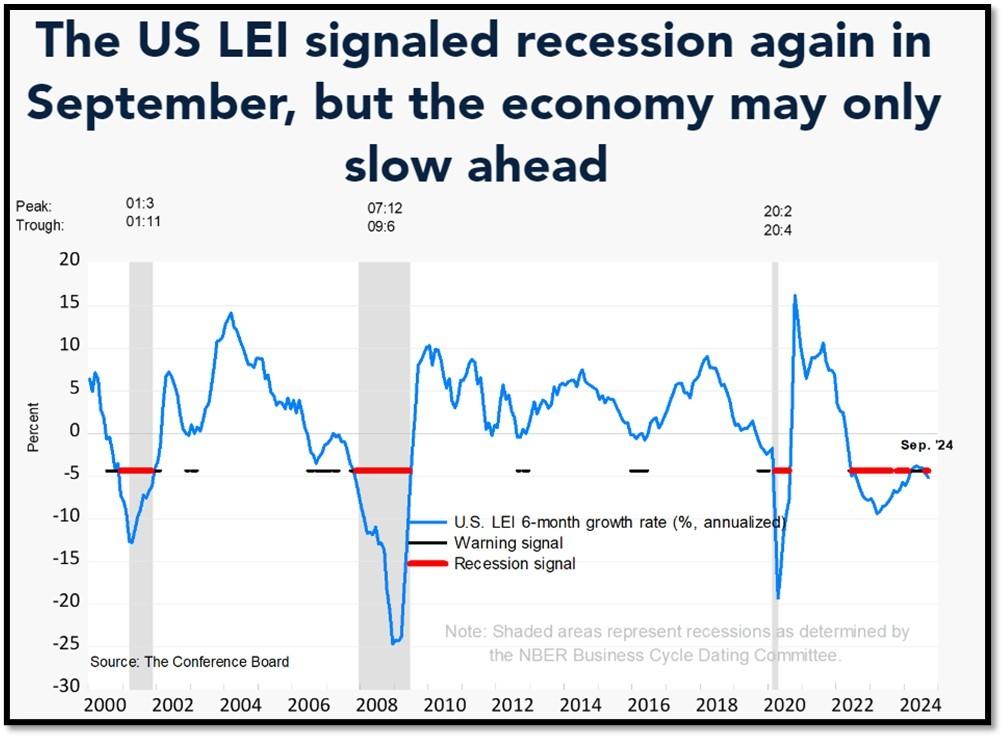
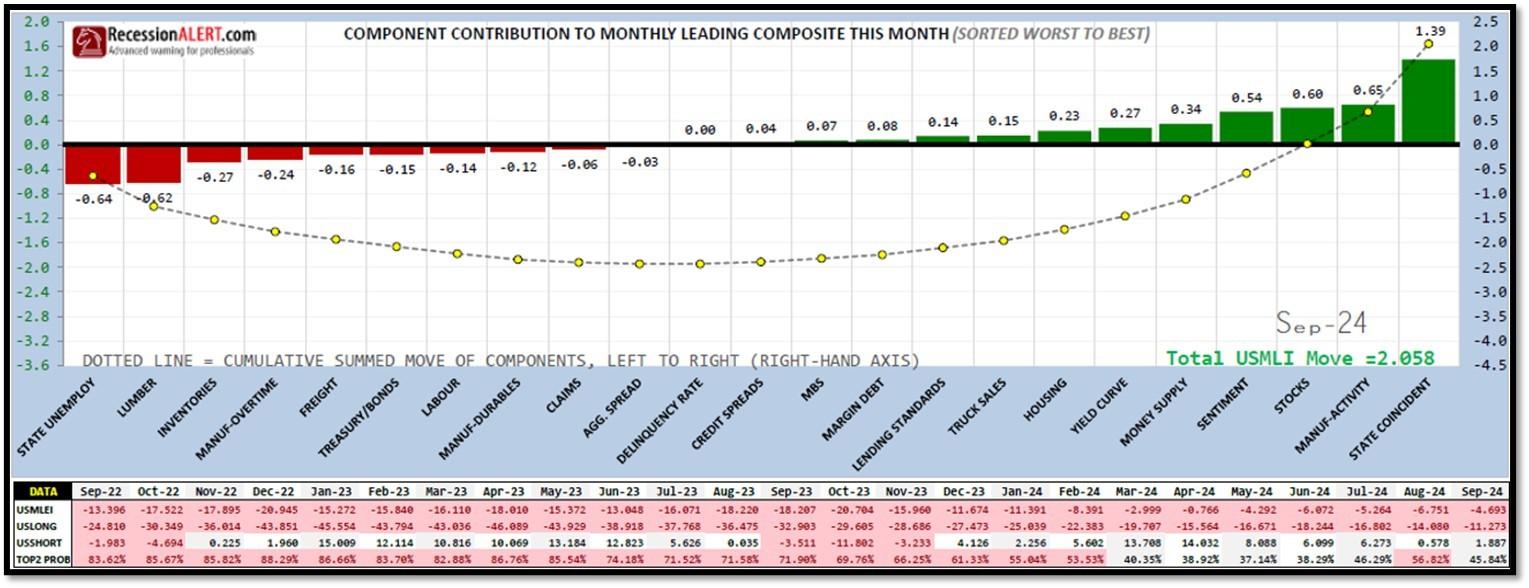
5F. Probability of U.S. falling into Recession within 3 to 4 months is currently at 65.88% (with data as of 11/4/2024 – Next Report 11/18/2024) according to RecessionAlert Research. Last release’s data was at 66.48%. This report is updated every two weeks. REF: RecessionAlertResearch
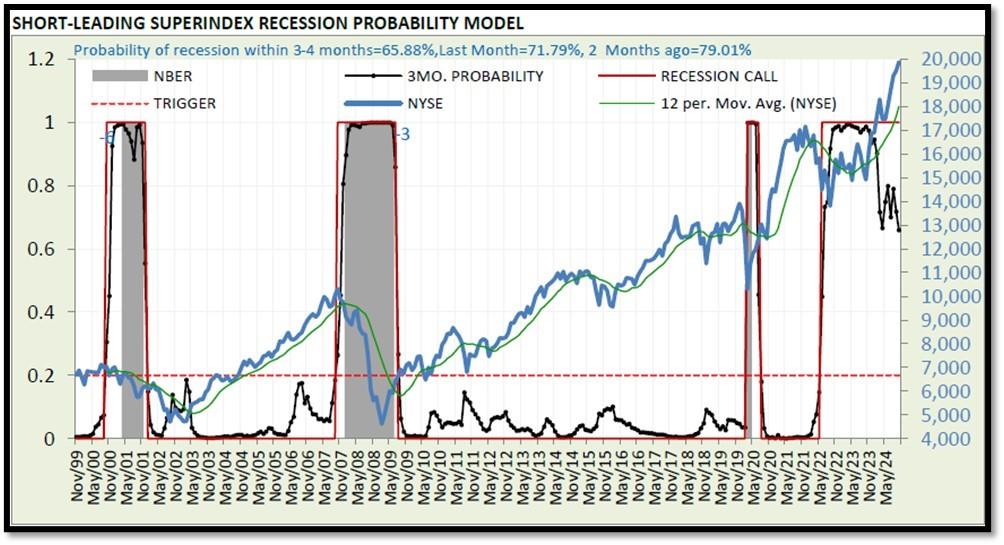
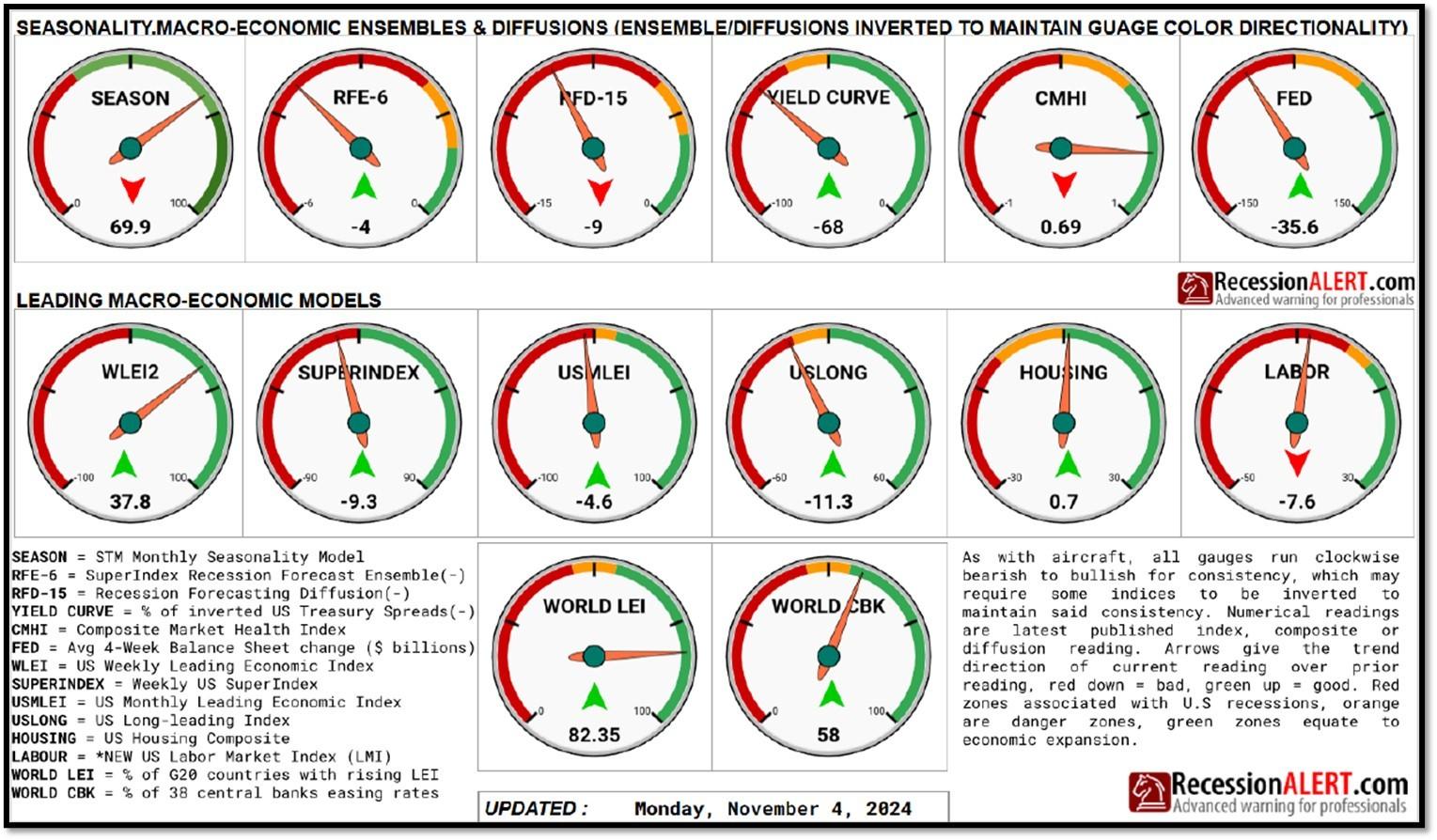
5G. Yield Curve as of 11/4/2024 is showing Flattening. Spread on the 10-yr Treasury Yield (4.29%) minus yield on the 2-yr Treasury Yield (4.16%) is currently at 13 bps. REF: Stockcharts The yield curve—specifically, the spread between the interest rates on the ten-year Treasury note and the three-month Treasury bill—is a valuable forecasting tool. It is simple to use and significantly outperforms other financial and macroeconomic indicators in predicting recessions two to six quarters ahead. REF: NYFED
5H. Recent Yields in 10-Year Government Bonds. REF: Source is from Bloomberg.com, dated 11/4/2024, rates shown below are as of 11/4/2024, subject to change.
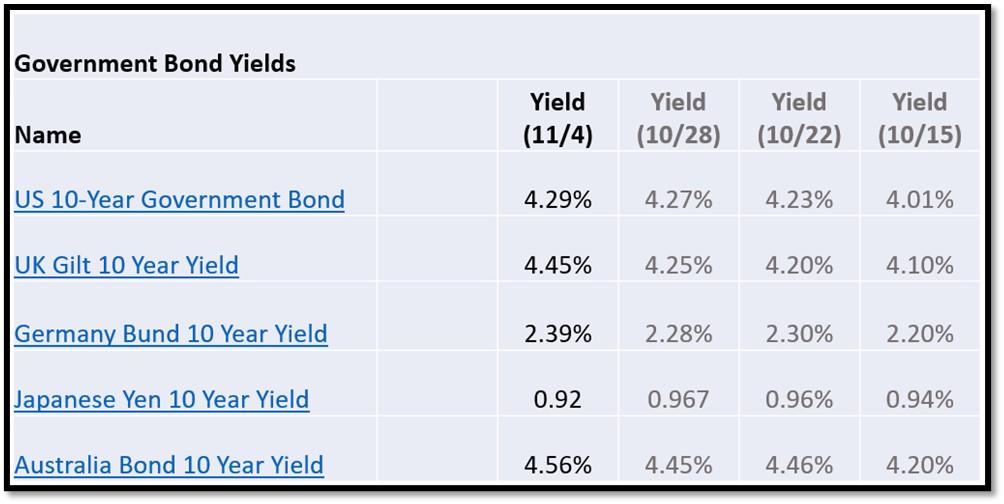
The 10-Year US Treasury Yield… REF: StockCharts1, StockCharts2
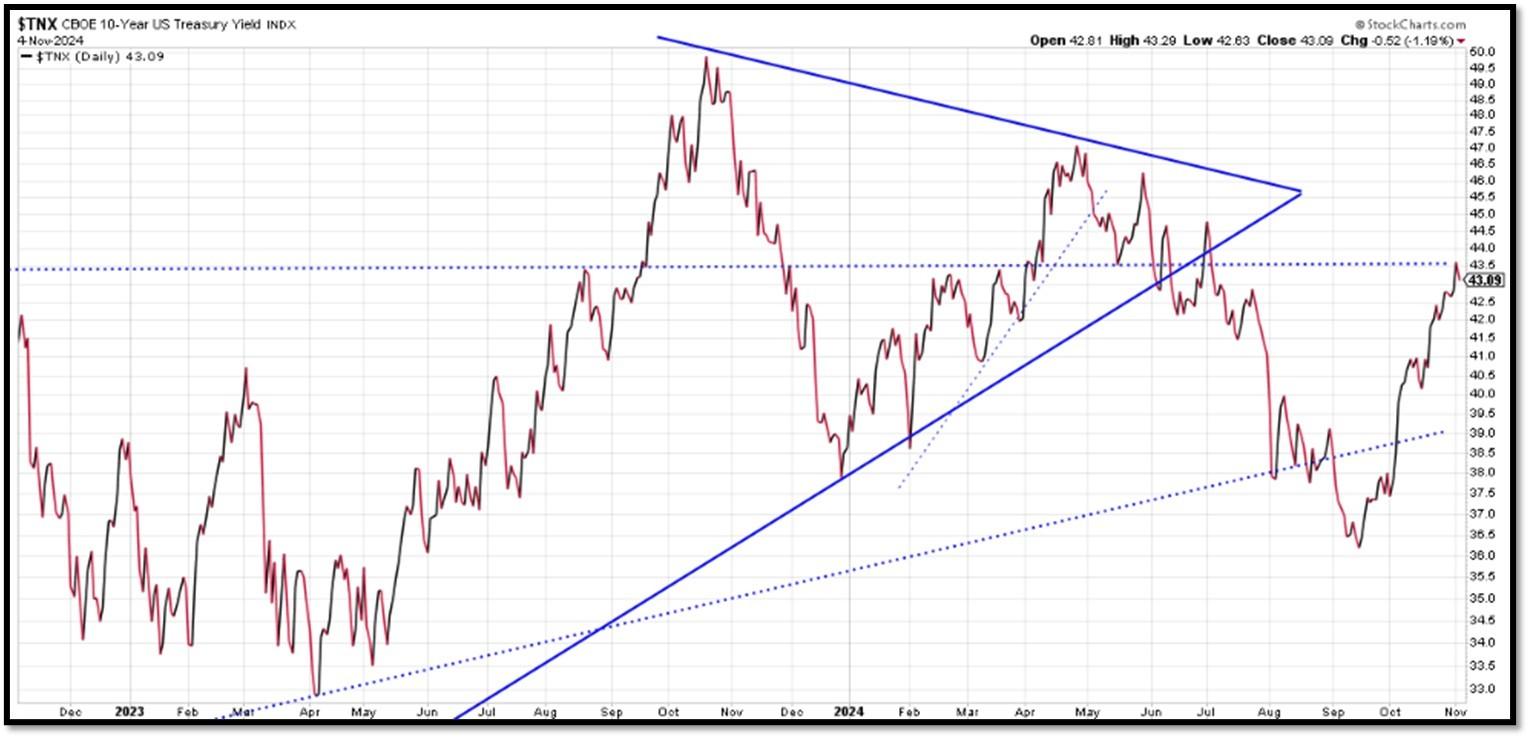
The 10-year yield – Spiked towards top of trend…
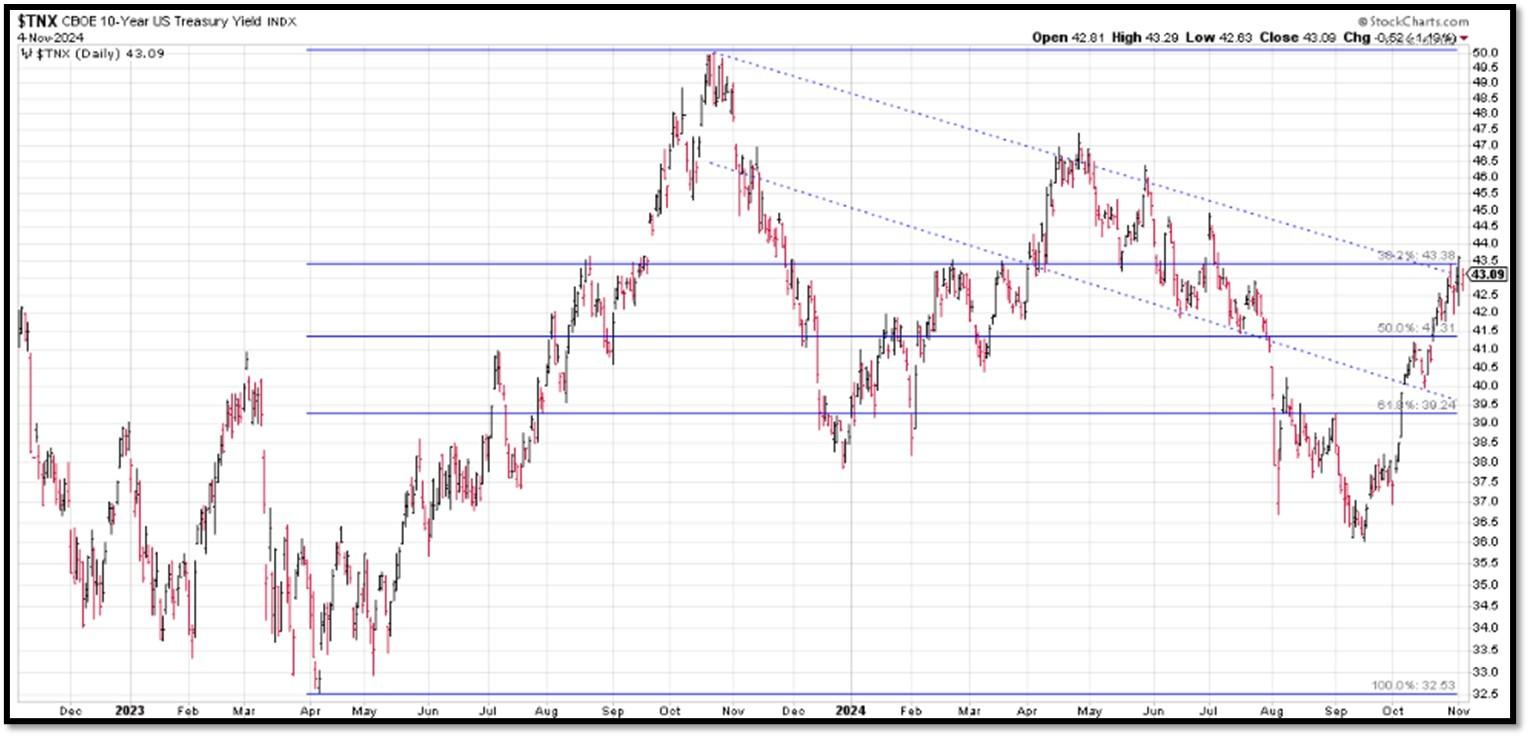
10-Year Real Interest Rate at 1.5016% as of 10/10/24. REF: REAINTRATREARAT10Y
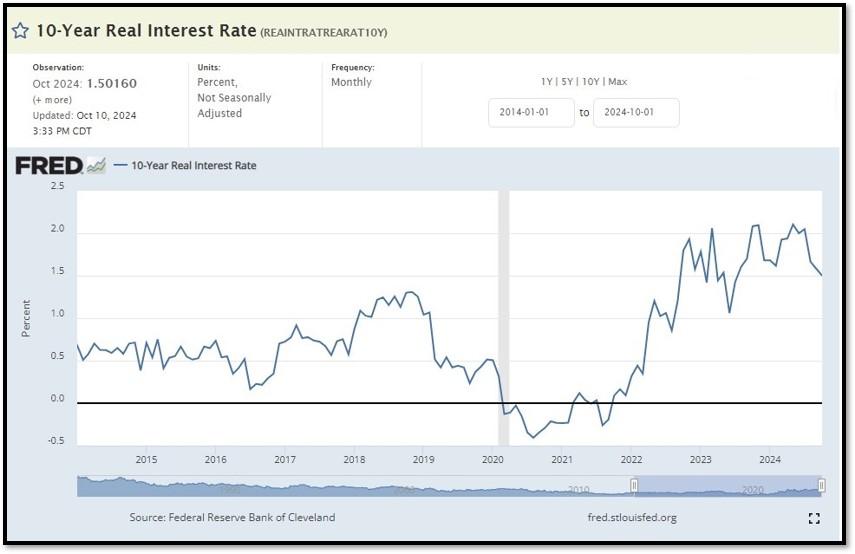
Federal government Interest Payments increased $22B to $1.096 T as of Q2-2024. REF: FRED-A091RC1Q027SBEA

Interest payments as a percentage of GDP increased from 1.84853 in 2022 to 2.37794 as of 10/18/24. REF: FRED-FYOIGDA188S
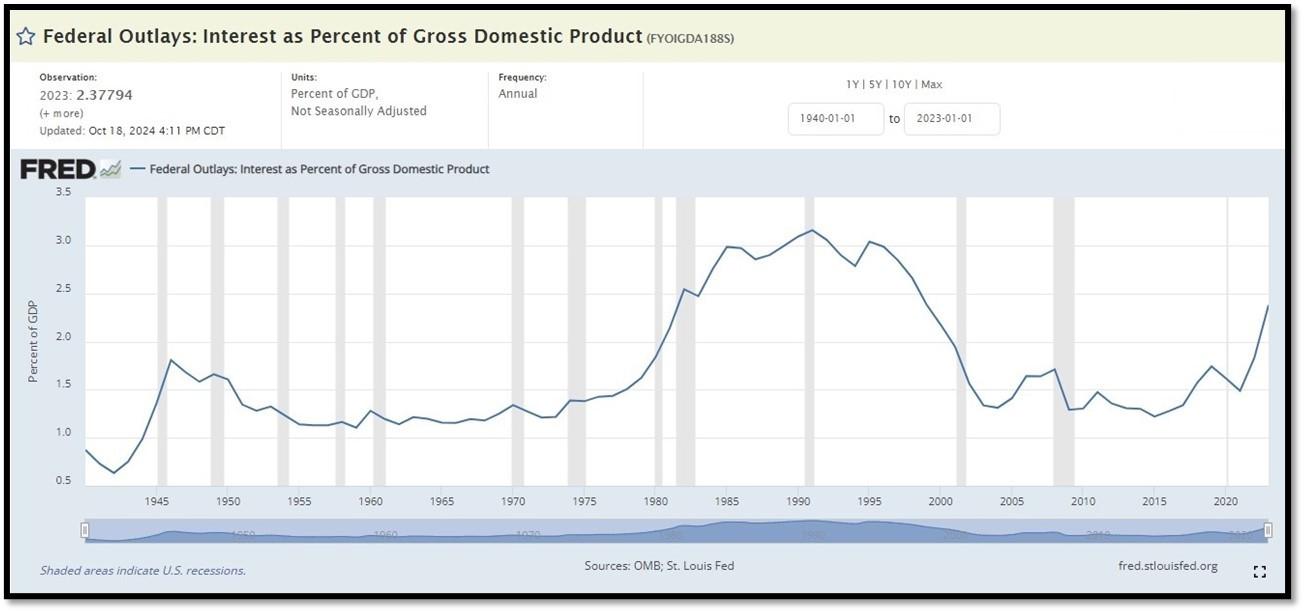
5I. (11/4/2024) Today’s National Average 30-Year Fixed Mortgage Rate is 7.05% (All Time High was 8.03% on 10/19/23). Last week’s data was 7.00%. This rate is the average 30-year fixed mortgage rates from several different surveys including Mortgage News Daily (daily index), Freddie Mac (weekly survey), Mortgage Bankers Association (weekly survey) and FHFA (monthly survey). REF: MortgageNewsDaily, Today’s Average Rate
The recent spike in the 30-year fixed-rate jumbo mortgage to 7%, compared to Freddie Mac’s rate at 6.54% and the Mortgage Bankers Association (MBA) rate at 6.52%, highlights key differences in the mortgage market. Jumbo mortgages, which exceed the conforming loan limits set by government agencies like Freddie Mac, typically carry higher interest rates because they are riskier for lenders. These loans are not backed by government entities, which increases the risk for lenders and, consequently, leads to higher rates. In contrast, Freddie Mac and MBA provide averages for conforming loans, which meet federal guidelines and have lower risk due to government backing, keeping their rates lower.
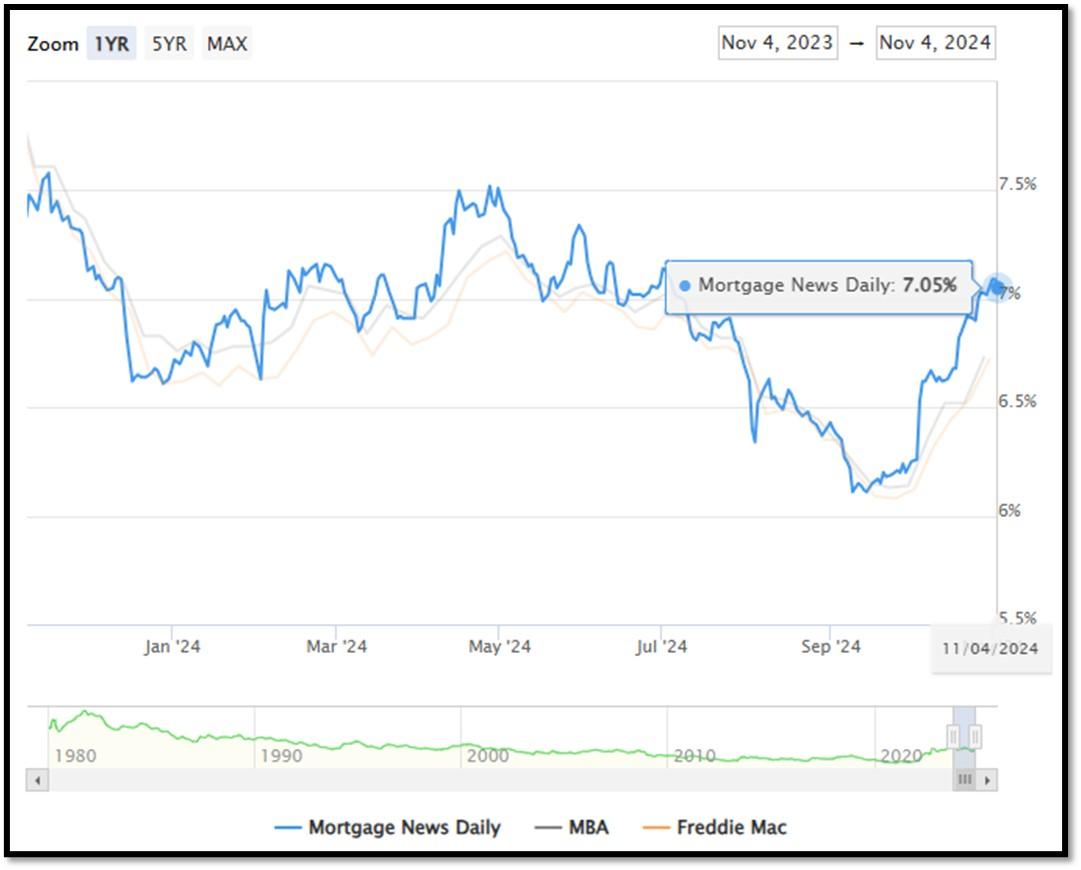
(10/15/24) Housing Affordability Index for Aug = 98.6 // July = 95 // June = 93.3 // May = 93.1 // April = 95.9 // March = 101.1 // February = 103.0. Data provided by Yardeni Research. REF: Yardeni

5J. Velocity of M2 Money Stock (M2V) with current read at 1.389 as of (Q2-2024 updated 10/30/2024). Previous quarter’s data was 1.385. The velocity of money is the frequency at which one unit of currency is used to purchase domestically- produced goods and services within a given time period. In other words, it is the number of times one dollar is spent to buy goods and services per unit of time. If the velocity of money is increasing, then more transactions are occurring between individuals in an economy. Current Money Stock (M2) report can be viewed in the reference link. REF: St.LouisFed-M2V
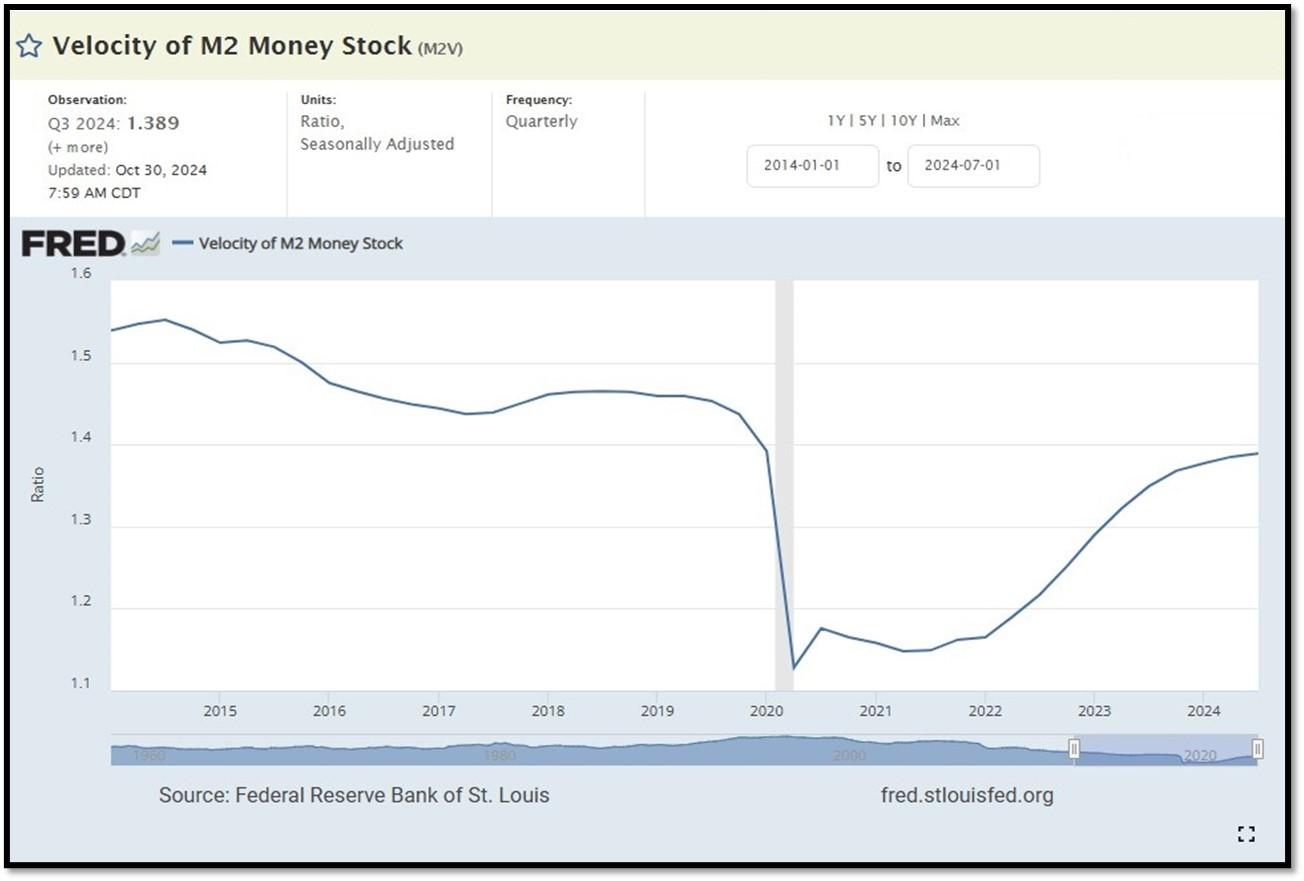
M2 consists of M1 plus (1) small-denomination time deposits (time deposits in amounts of less than $100,000) less IRA and Keogh balances at depository institutions; and (2) balances in retail MMFs less IRA and Keogh balances at MMFs. Seasonally adjusted M2 is constructed by summing savings deposits (before May 2020), small-denomination time deposits, and retail MMFs, each seasonally adjusted separately, and adding this result to seasonally adjusted M1. Board of Governors of the Federal Reserve System (US), M2 [M2SL], retrieved from FRED, Federal Reserve Bank of St. Louis; Updated on October 22, 2024. REF: St.LouisFed-M2
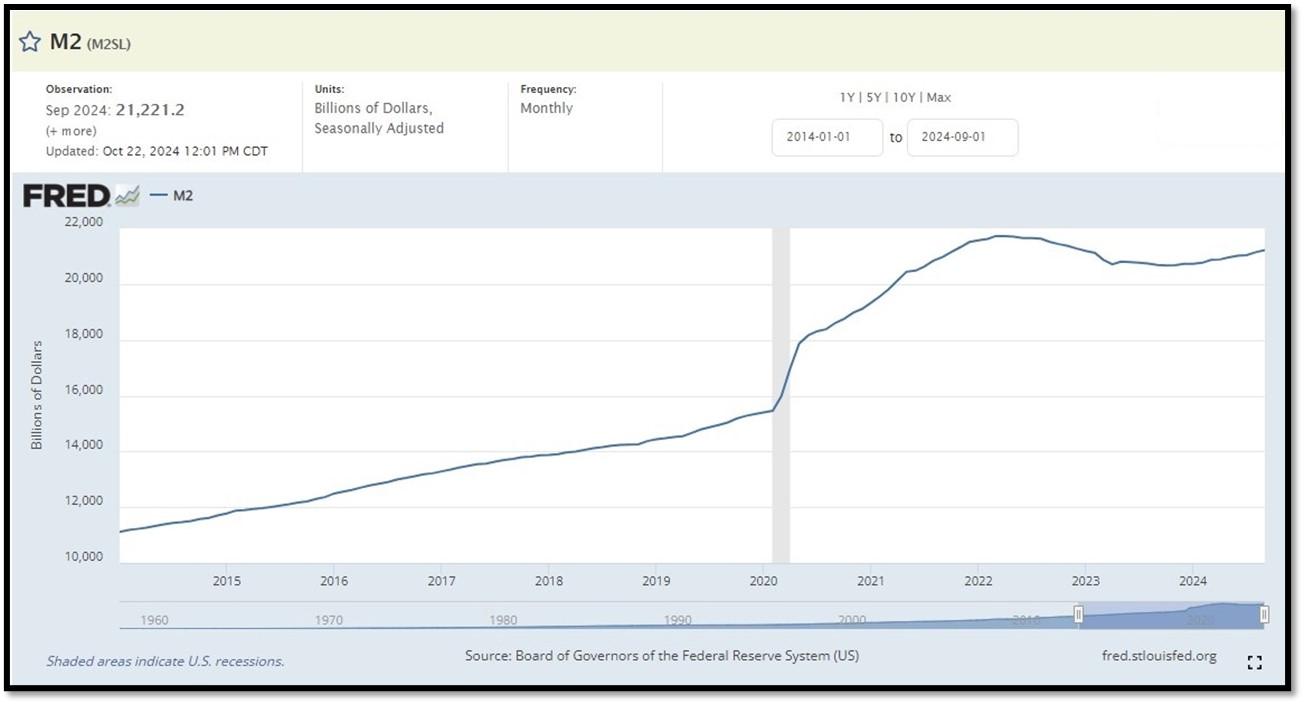
Money Supply M0 in the United States decreased to 5,588,400 USD Million in September from 5,670,200 USD Million in August of 2024. Money Supply M0 in the United States averaged 1,149,440.43 USD Million from 1959 until 2024, reaching an all-time high of 6,413,100.00 USD Million in December of 2021 and a record low of 48,400.00 USD Million in February of 1961. REF: TradingEconomics, M0
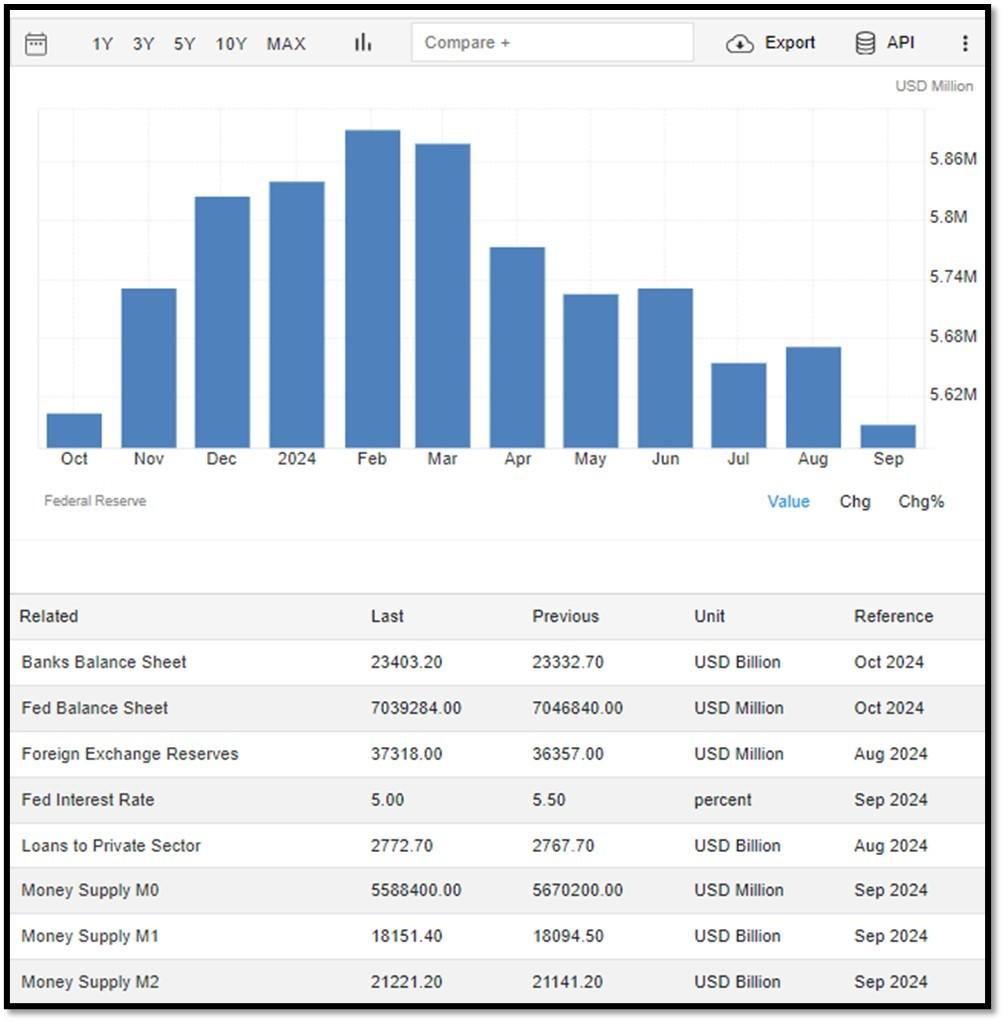
5K. In September, the Consumer Price Index for All Urban Consumers rose 0.2 percent, seasonally adjusted, and rose 2.4 percent over the last 12 months, not seasonally adjusted. The index for all items less food and energy increased 0.3 percent in September (SA); up 3.3 percent over the year (NSA). October 2024 CPI data are scheduled to be released on November 13, 2024, at 8:30AM-ET. REF: BLS, BLS.GOV
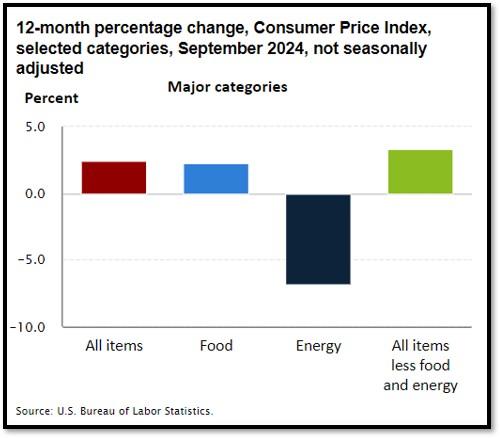
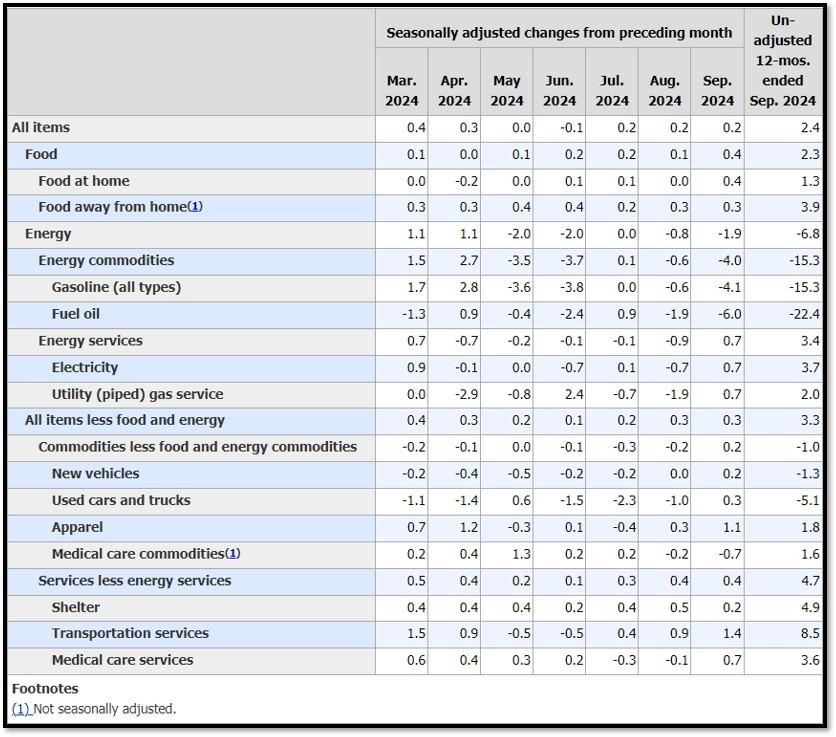
5L. Technical Analysis of the S&P500 Index. Click onto reference links below for images.
- Short-term Chart: Bullish/Falling on 11/4/2024 – REF: Short-term S&P500 Chart by Marc Slavin (Click Here to Access Chart)
- Medium-term Chart: Bullish on 11/4/2024 – REF: Medium-term S&P500 Chart by Marc Slavin (Click Here to Access Chart)
- Market Timing Indicators – S&P500 Index as of 11/4/2024 – REF: S&P500 Charts (7 of them) by Joanne Klein’s Top 7 (Click Here to Access Updated Charts)
- A well-defined uptrend channel shown in green with S&P500 getting back on trend. REF: Stockcharts
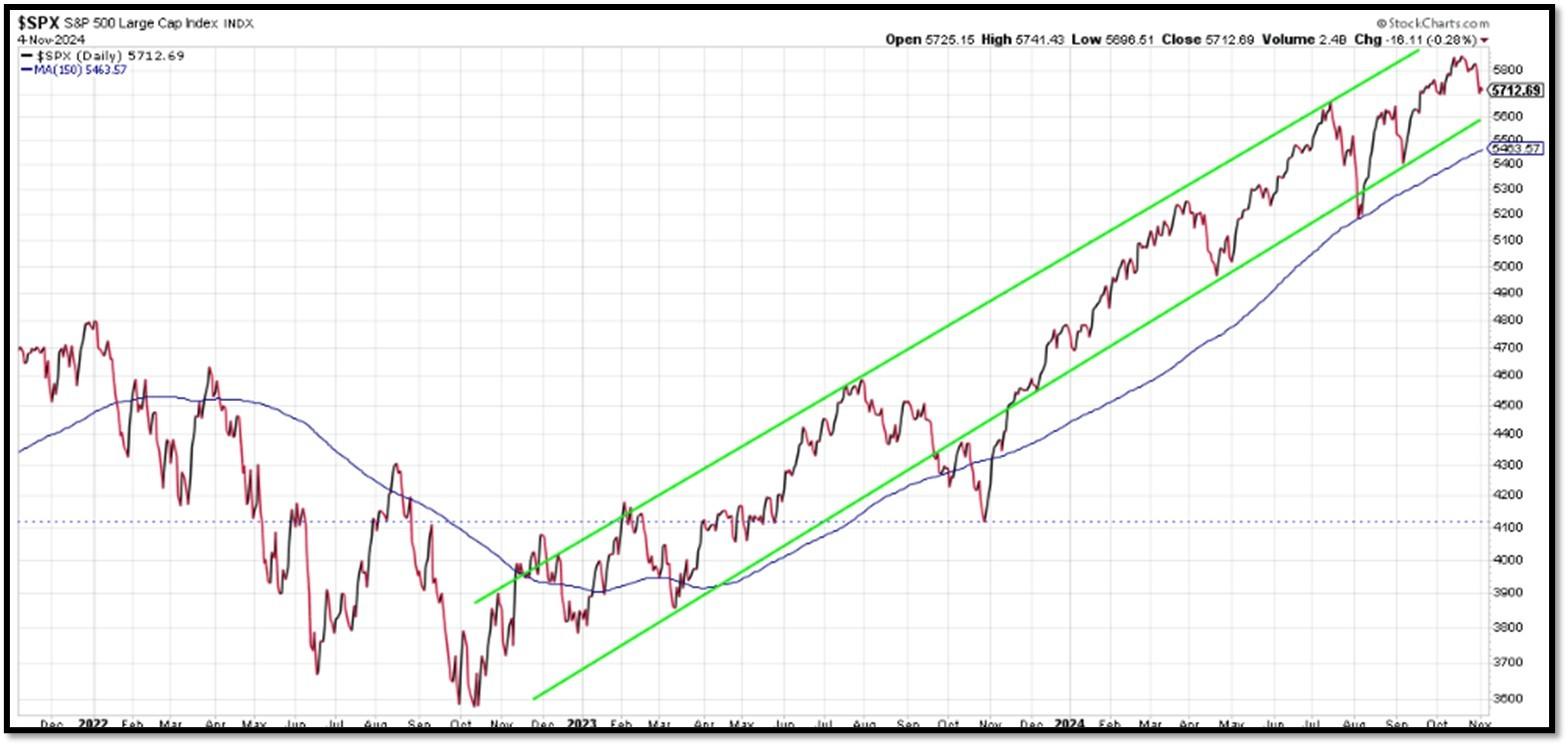
- S&P500 and CBOE Volatility Index (VIX) as of 11/4/2024. REF: FRED, Today’s Print
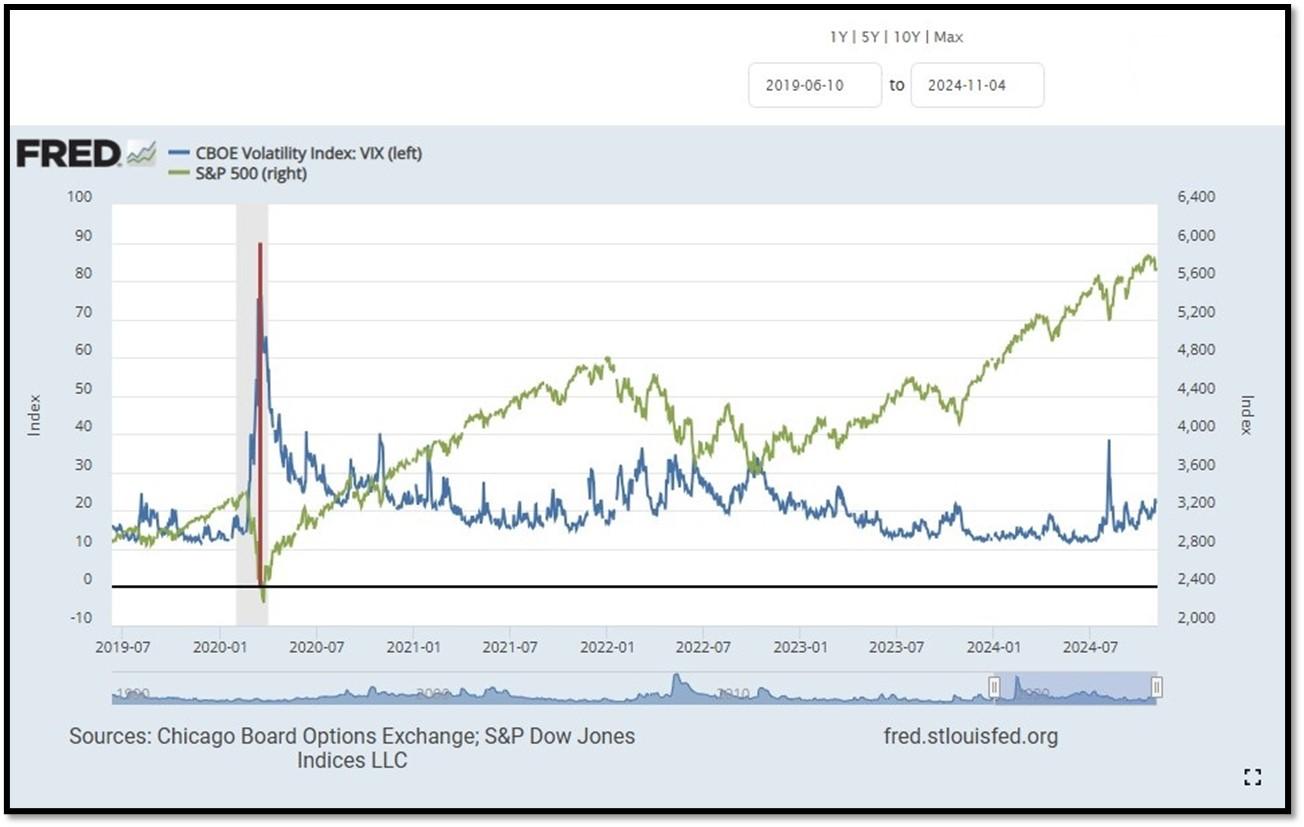
5M. Most recent read on the Crypto Fear & Greed Index with data as of 11/5/2024au is 70 (Greed). Last week’s data was 72 (Greed) (1-100). Fear & Greed Index – A Contrarian Data. The crypto market behavior is very emotional. People tend to get greedy when the market is rising which results in FOMO (Fear of missing out). Also, people often sell their coins in irrational reaction of seeing red numbers. With the Crypto Fear and Greed Index, the data try to help save investors from their own emotional overreactions. There are two simple assumptions:
- Extreme fear can be a sign that investors are too worried. That could be a buying opportunity.
- When Investors are getting too greedy, that means the market is due for a correction.
Therefore, the program for this index analyzes the current sentiment of the Bitcoin market and crunch the numbers into a simple meter from 0 to 100. Zero means “Extreme Fear”, while 100 means “Extreme Greed”. REF: Alternative.me, Today’sReading
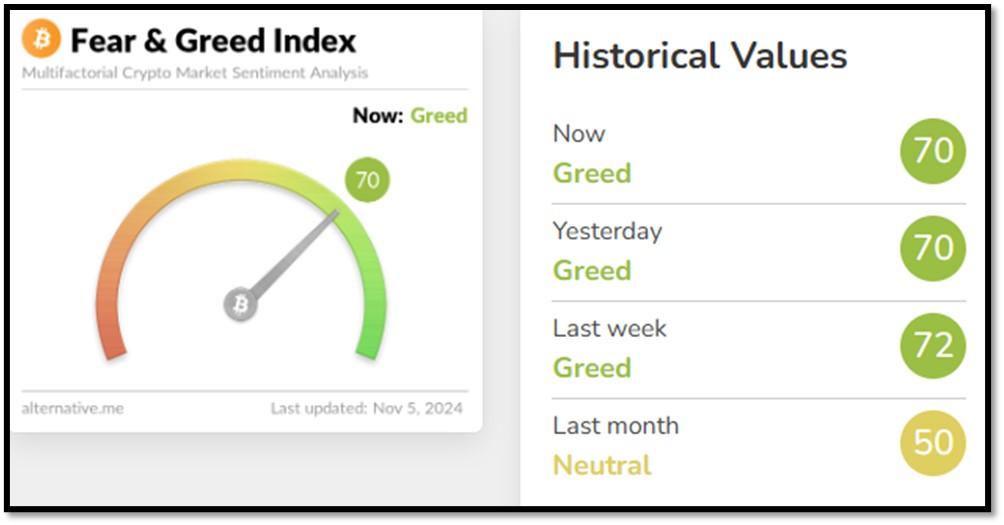
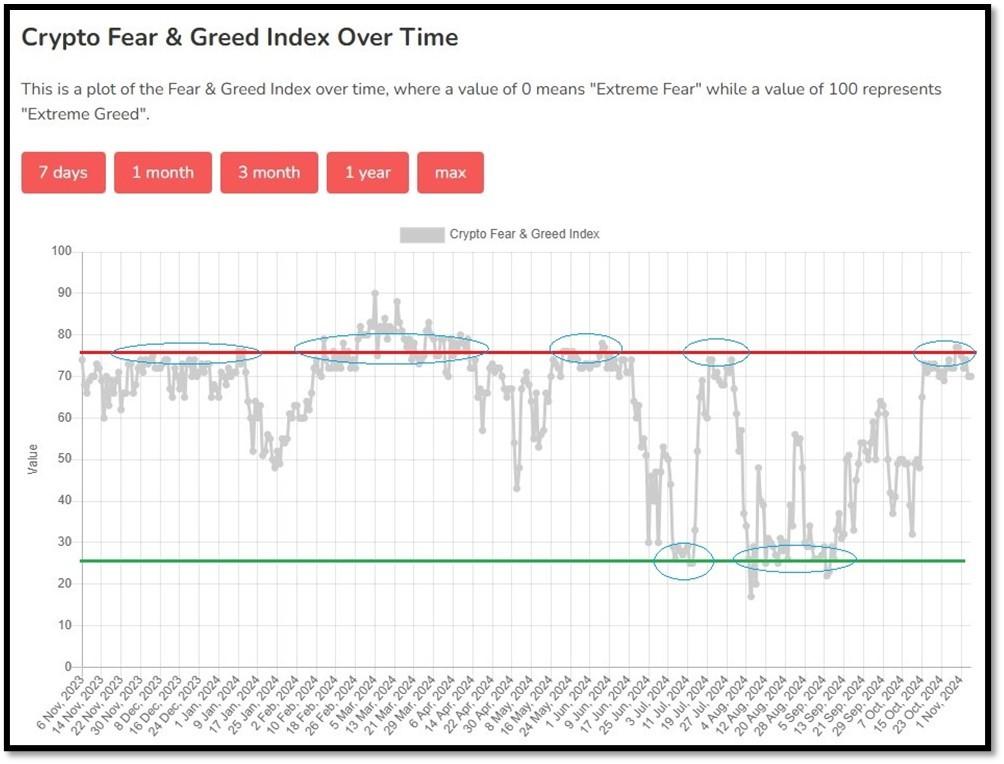
Bitcoin – Could it break out to the upside? REF: Stockcharts
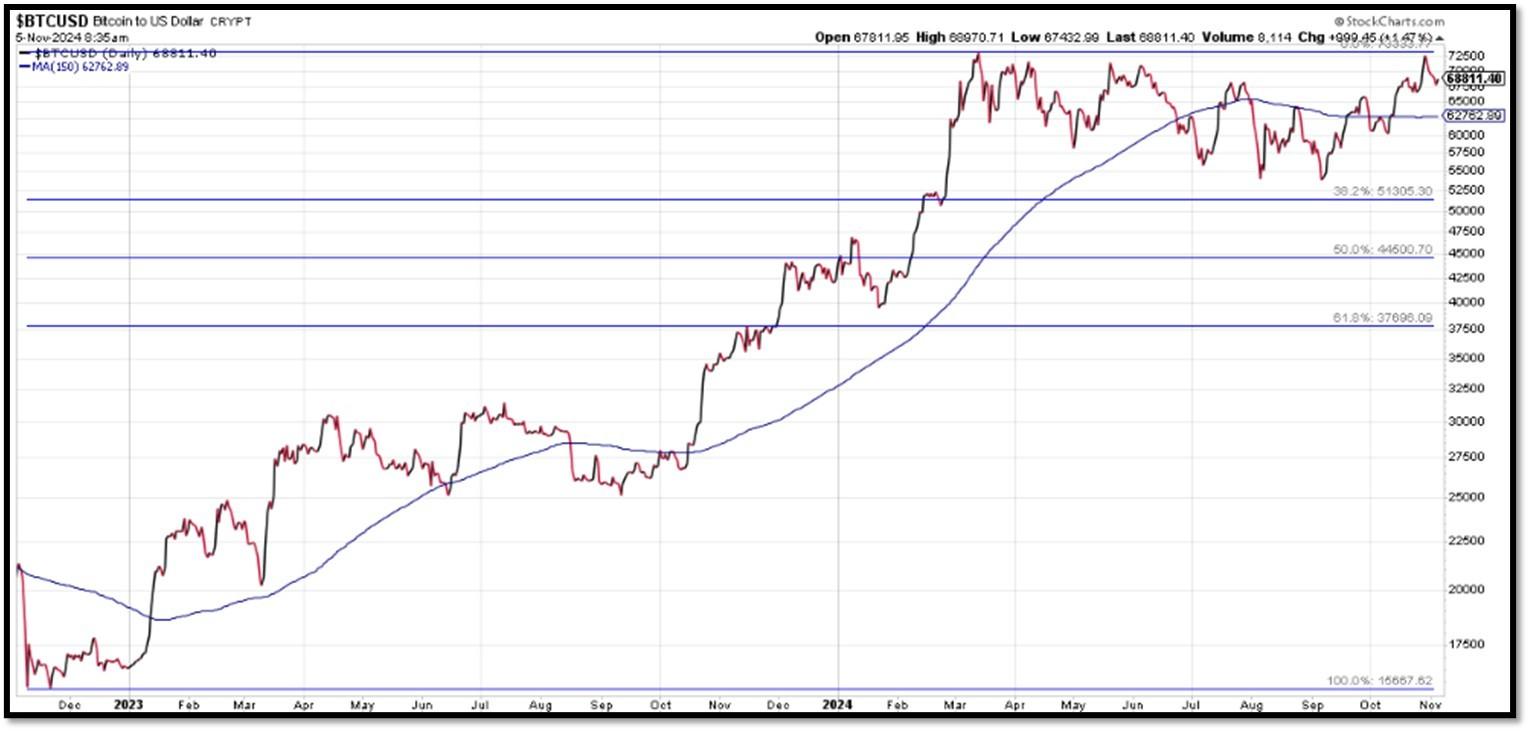

Len writes much of his own content, and also shares helpful content from other trusted providers like Turner Financial Group (TFG).
The material contained herein is intended as a general market commentary, solely for informational purposes and is not intended to make an offer or solicitation for the sale or purchase of any securities. Such views are subject to change at any time without notice due to changes in market or economic conditions and may not necessarily come to pass. This information is not intended as a specific offer of investment services by Dedicated Financial and Turner Financial Group, Inc.
Dedicated Financial and Turner Financial Group, Inc., do not provide tax, legal or accounting advice. You should consult your own tax, legal and accounting advisors before engaging in any transaction.
Any hyperlinks in this document that connect to Web Sites maintained by third parties are provided for convenience only. Turner Financial Group, Inc. has not verified the accuracy of any information contained within the links and the provision of such links does not constitute a recommendation or endorsement of the company or the content by Dedicated Financial or Turner Financial Group, Inc. The prices/quotes/statistics referenced herein have been obtained from sources verified to be reliable for their accuracy or completeness and may be subject to change.
Past performance is no guarantee of future returns. Investing involves risk and possible loss of principal capital. The views and strategies described herein may not be suitable for all investors. To the extent referenced herein, real estate, hedge funds, and other private investments can present significant risks, including loss of the original amount invested. All indexes are unmanaged, and an individual cannot invest directly in an index. Index returns do not include fees or expenses.
Turner Financial Group, Inc. is an Investment Adviser registered with the United States Securities and Exchange Commission however, such registration does not imply a certain level of skill or training and no inference to the contrary should be made. Additional information about Turner Financial Group, Inc. is also available at www.adviserinfo.sec.gov. Advisory services are only offered to clients or prospective clients where Turner Financial Group, Inc. and its representatives are properly licensed or exempt from licensure. No advice may be rendered by Turner Financial Group, Inc. unless a client service agreement is in place.



